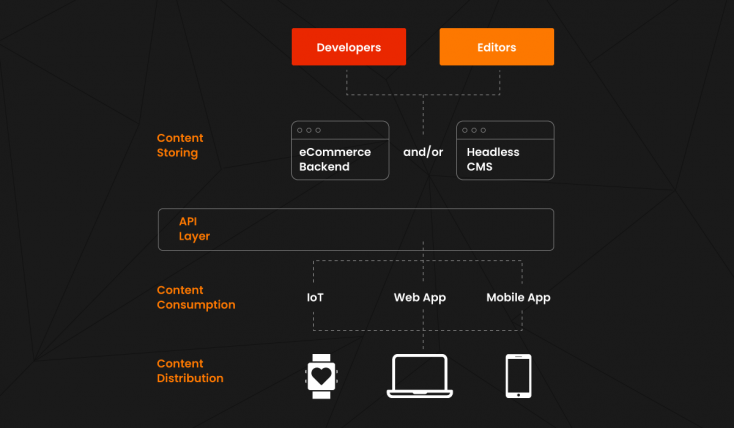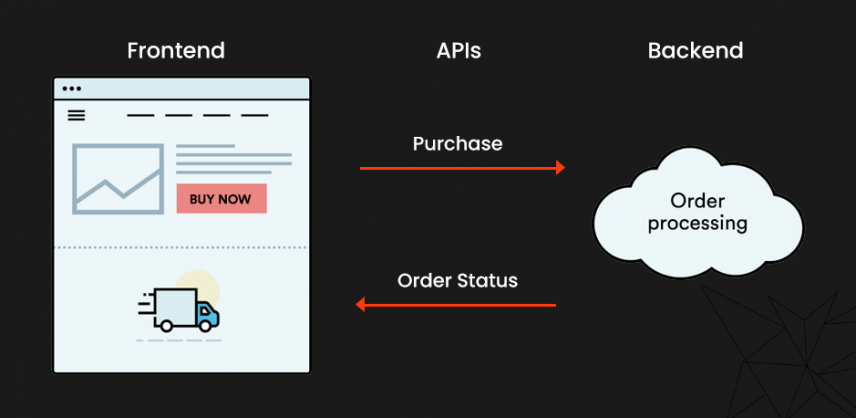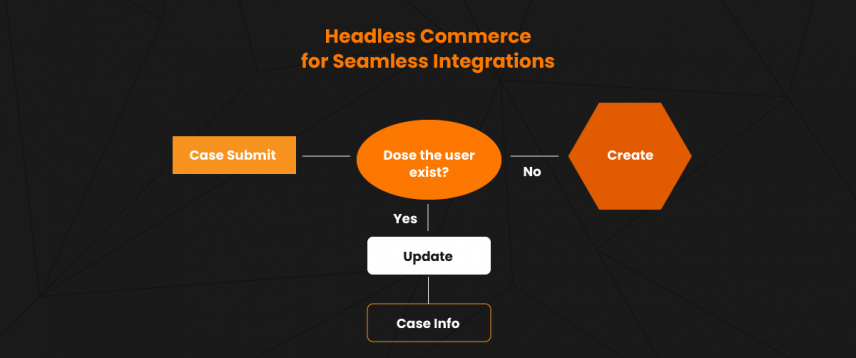Suppose a user wants information
about a placed/purchased order via the order detail page. Now an
eCommerce frontend only needs to know what API to call to the backend
and get information about this order placed. As long as the frontend
communicates with the backend through the API, it doesn’t have to know
anything about the backend or its complexity.
In
fact, in a headless commerce site, since the frontend is decoupled from
the backend, the entire backend system can be replaced or modified any
number of times without breaking or obstructing its functionality or
communication with the frontend as long as the new backend system
provides the correct response to the API call.
All
in all, in a headless commerce site, a user interacts with the frontend
of your eCommerce store via the website and requests information which
is communicated to the backend by the API. In return, the backend
supplies the requested information via the API, which is then displayed
as information on the frontend to a user.
By
decoupling the frontend and backend, you can make the latter more
generic that can interact with anything and is willing to send the right
API requests. Also, you can make any number (for mobile, web, kiosk,
smart devices, web apps, etc) and type of unique frontends since it
doesn’t have to deal with any processing, only displaying information to
the user.
Coming back to
the second part of the question; headless commerce is gaining tremendous
popularity mainly because of two factors-
First,
when eCommerce came into being, the idea was to make it
desktop-friendly since customers were new at online shopping and most
traffic came from desktops. As a result, all eCommerce solutions
developed during that time were full-stack, inclusive of frontend and
backend.
As the technology
evolved, so did the purchasing patterns, including mobile traffic and
other complex metrics like flexibility, scalability, and
easy-to-navigate solutions- making the execution of the coupled frontend
and backend systems tedious. Headless commerce allows brands to develop
a frontend and backend for their commerce site independently. A
front-end developer can make any change they like while only
understanding the backend interface- the APIs- and the backend
developers can enable new functionalities by supporting the new APIs. It
makes the development of an eCommerce site quicker and more agile.
Second,
eCommerce has become a soft spot for industries, and every brand wants
to expand in the online selling domain. It is easier to build a commerce
engine from an implementation standpoint and link it with a CMS than
creating a new website and migrating old content to it.
In
the wake of such factors, headless eCommerce is the perfect solution to
supplement modern needs, fulfill consumer demands, and maximize
profitability.
Headless commerce vs. traditional commerce: what’s the difference?
Still
wondering what makes it different from traditional commerce? Well,
here’s a comparison between headless commerce and traditional commerce
that’ll make your brain juices go running.
Frontend and backend development:
Traditional commerce:
You might think that the overall design process might be manageable via
a standard commerce platform; however, the reality is the opposite.
Developers encounter several constraints when coding websites using
traditional commerce. To change any functionality, you have to spend so
much time editing data in the model, the code, and the frontend
platform. To upgrade to future versions, they might have to go through
the same lengthy process again.
Headless commerce:
Once the frontend is removed, developers can create a user experience
from scratch, which fits their core business values. Developers can
freely modify databases in the backend while on the frontend; all they
have to do is make a simple API call. In simpler words, developers are
free from the limitations suffered during traditional commerce
development.
However,
headless commerce is not one without its drawbacks. Since there is no
frontend presentation layer, marketers have to build everything from the
start, be it product pages, landing pages, or more. So, developing an
eCommerce web design becomes an even more daunting task, which is why
developers prefer the decoupled solution to the headless commerce one.
Personalization & customization:
Traditional commerce:
Such websites have a predefined user experience that mostly is
difficult to personalize for each visitor. That said, these platforms
have little to no room for customization and personalization. As a
brand, if you’re happy with extending that type of experience to your
visitors, then go with it; otherwise, opt for headless commerce.
Headless commerce:
Unlike traditional commerce, where there is a set architecture for what
passes as a positive user experience, headless commerce platforms act
pretty contrary to it. There is no front end in a headless eCommerce
platform, which means developers can create any experience they like.
Also, such prospects give developers better control over the look and
feel of the eCommerce platform and by extension, establish authority
over admin user and consumer experience.
Flexibility & adaptability:
Traditional commerce:
In such a setup, the frontend couples with the backend in a somewhat
friendly manner. Hence, it leaves no space to implement desired
customizations. Even if you could do it, you will have to edit multiple
layers of coding between frontend and backend via the database to let it
reflect on the eCommerce platform.
Headless commerce:
Since there is no link between frontend and backend, it empowers
developers with endless possibilities for whatever customization they
want. You can make changes, big or small, by implementing a new field to
the database layer and execute the command in a headless commerce
architecture.
Content delivery:
Traditional Commerce:
In a conventional eCommerce platform, a developer codes the frontend to
pull the content needed every time, as and when needed, increasing the
number of API calls. Since the resources aren’t shared, coupled
eCommerce platforms slow down during peak traffic times.
Headless Commerce:
The lack of a frontend makes API calls easier. These APIs calls are
used to pull data, and since it is not restricted or dependent on other
processes or code, it makes the overall system faster, which works
great, especially during peak traffic times.
Improved security:
Traditional Commerce: In
such a networked environment, the business systems are combined with
the access control lists (ACLs). It means the database is entirely
visible to all the other systems and users. It creates havoc and weakens
security systems.
Headless Commerce:
In the headless commerce atmosphere, all the systems rely on each other
for reliable final output. Also, the business systems stay separate but
consistent with the access control units (ACL) to limit access to other
systems and users. In the long run, it eliminates the possibility of a
compromised account and weak security.
Headless commerce: the top benefits
Want a big shot headless commerce website example?
Amazon!
The
top eCommerce platform doesn’t stay constrained by the bounds of a
traditional system. Even so, over 60% of online streamers prefer Amazon
Prime-like service that you can’t achieve with a conventional commerce
setup.
All in all,
headless commerce is a boon for brands who want to extend personalized
and customized services but don’t know how to do it. As for other brands
who still haven’t figured out the utter need for headless commerce
platforms, the following reasons will indeed persuade you.
Go fully Omnichannel:
If
you wish your content to have the same look and feel anywhere and
everywhere, then go for a headless content management system. For an
eCommerce brand, an omnichannel experience will correspond to delivering
products, product videos, or blog posts to any channel prevalent in
today’s world or ones that emerge in the future.
Lead the competition:
The
most irritating thing about developing a platform in traditional
commerce is that developers will have to change the frontend and backend
whenever an update needs implementation. So, as an eCommerce store, if
you wish to speed up adopting consumer technology, you can’t do it
easily and quickly with a traditional commerce solution.
However,
a headless commerce platform functions oppositely. It enables you to
deploy rapid updates without impacting the backend. More so, you can
easily make changes to your frontend without spending too much time on
it. Considering the rapidity at which technology modernizes, headless
eCommerce is the only solution if you need to keep pace.
Then again, major commerce brands deploy new updates every few weeks, while Amazon does it every 11.7 seconds. And we know now why it leads the race.
Works best for agile marketing:
Headless
commerce solutions are technology-friendly; it supports it as and when
it comes. It is perfect for brands when designing new consumer
experiences. Also, it places your marketing team back in the game where
they can roll out multiple sites across different brands, geographies,
portfolios, and divisions.
Owing
to the flexibility of headless commerce solutions, marketing teams can
set up sites in days and weeks and not months and years, reducing the
overall campaign launch hours.
Making customers feel connected to the brand:
Indeed,
customers demand changes at lightspeed; however, their objective
remains the same- to achieve a personal and consistent experience across
all devices and channels.
Customers
like buying more from headless commerce stores only because it
understands their needs. A developer can use the backend data regarding
customer preferences and use this to power personalization engines on
the CMS, mobile apps, and social channels.
Allow seamless integrations:
By
superiority, headless commerce platforms must have an API that makes it
easier to integrate and communicate with different channels. It must be
compatible with any new or old device to reach more customers, find
more opportunities, and grow your brand. More so, it should not take
months to allow for such integrations, rather hours









